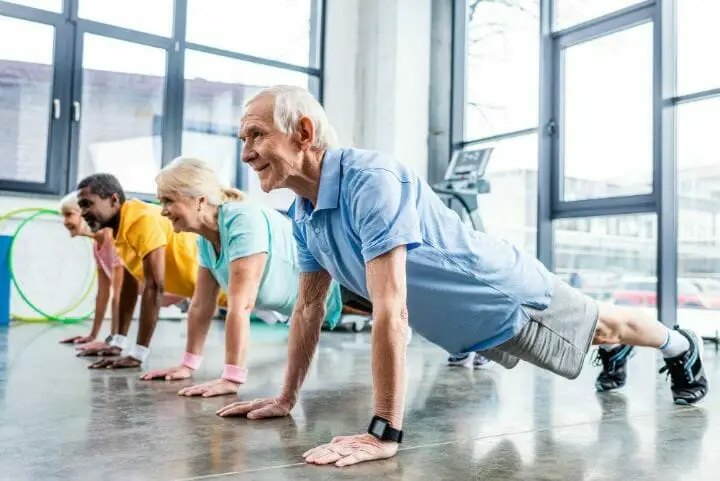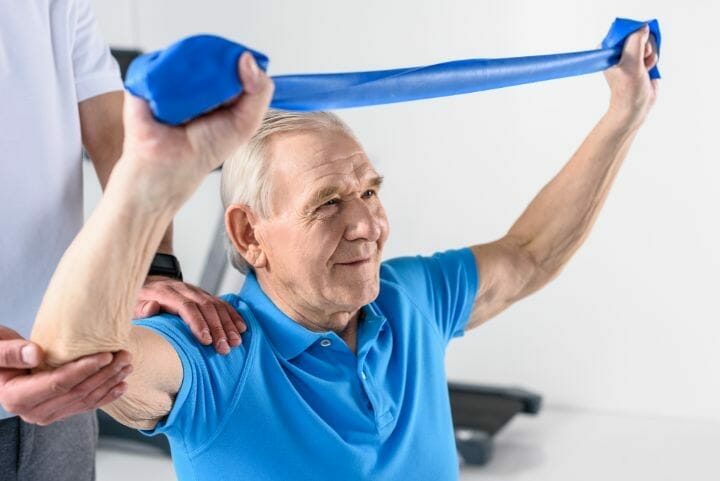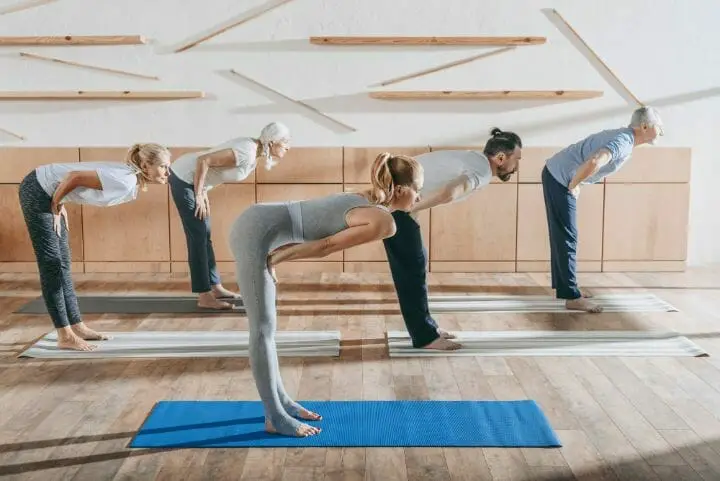Osteoporosis is a bone disease that causes loss of bone mass and bone density. Osteoporosis adversely impacts bone health, causing bone fracture, especially in the femoral neck, lumbar spine, or rotator cuff region.

It impairs the mobility and independence of the person. Osteoporosis results in thinner and fragile bones, as the disease decreases the bone mineral density, causing bone fractures. It also reduces bone mass and bone health.
Many people gradually face bone loss over a period of several years. There are no visible symptoms indicating the start of bone loss and most often, older adults are aware of osteopenia and osteoporosis only after an unfortunate event like a vertebral fracture occurs.
Contents
Bone Mineral Density(BMD) and Isometric Exercises
Here are some facts pertaining to bone health and how isometric exercises affect bones.
- Decreases lumbar spine BMD is a major public health problem among postmenopausal women.
- As it is capable of detecting instability in cortical bone, the Bone Mineral Density of Femoral neck will predict the susceptibility to hip fracture in the case of elderly people.
- Isometric exercises for osteoporosis are effective for weakened bone density. It can also increase the density of an injured bone.
So, the good news is that osteopenia and osteoporosis are treatable bone diseases. Medications and supplements, exercises, and a healthy diet plan for osteoporosis can help the patient live well with osteoporosis.
Exercises help improve bone health. It helps in elevating the bone mineral density and decrease the risk of bone fractures. Physical activity, especially for postmenopausal women, can increase muscle strength, improve overall balance, reduce the risk of bone fractures, improve the posture of the body, and decrease pain or cause pain relief.
Stretching exercises, resistance exercise, aerobic exercise, and weight-bearing exercises, are the safest activities for people diagnosed with osteoporosis. These improve muscle strength and bone formation and combat bone loss, improving overall bone health.
Choosing the Right Physical Exercise for Osteoporosis
We recommend that you consult a doctor before choosing an exercise program if you have been diagnosed with osteoporosis.
Testing for bone density is a good way of determining an appropriate exercise program. Generally, osteoporosis patients are advised to try strengthening exercises for the upper back, resistance exercises, and weight-bearing exercises for muscle strengthening while keeping bone metabolism healthy.
There is a wide range of exercise programs you can choose from. For ensuring safety during exercise or training for osteoporosis, the following guidelines must be kept in mind:
Minimal Impact
The general advice is to minimize high-impact physical activity. For instance, jumping jacks, running, and burpees can place unwanted stress on your spine and joints. These activities might lead to a decrease in bone density and may cause bone fractures.
Spinal Movements
We recommend that you avoid rounded spinal movements. Sit-ups, toe touches, and rowing machines, golf, tennis, bowling, and certain yoga pose may also include some twists at the waist. Talk to your doctor or fitness professional who is aware of your condition before you start to practice.
Strength Training
Strength training mainly includes the use of free weights, bodyweight or resistance bands or resistance bow, muscle strengthening, and all significant bones (especially spinal muscles good for posture). Resistance training can also help maintain bone mineral density.

Although spine extension holds are good for correcting thoracic kyphosis and muscle strengthening, it is best to consult with your doctor before practice.
While using weight machines, care must be taken to not impact the already weak erector spinae muscle.
Resistance training must be tailored to the ability and tolerance of the person diagnosed with osteoporosis. A physical therapist or professional trainer with experience working with people with osteoporosis can help develop strength-training routines. The right technique and form are vital to prevent injuries and osteoporotic fractures.
Flexibility exercises
Mobility of joints through their full range of motion helps in keeping the muscles well in shape and working. Stretches should be performed after the muscles are warmed up for the session. Always ensure that you move slowly and stay in proper form.
Stability and balance exercises
Balancing and stability exercises help the muscles work together to keep the body more stable and decrease your risk of falling. Simple and easy activities like standing on one leg or movement-based exercises like tai chi may improve stability and balance. Yoga for osteoporosis is also a great way for increasing balance. The tree pose and mountain pose are easy to do and elevate your balance.
You may also like Best Weighted Vest for Osteoporosis
Exercises for Osteoporosis
Weight-bearing Exercises and Aerobic Exercises
Cardiovascular exercises are the perfect regimen for bone and muscle strengthening and building bone density when performed on the feet. Weight-bearing exercises use gravity to exert a force on the bones while remaining upright.

The muscle strength and tendon strength are forced to pull on the bones. This then stimulates the bone cells to grow and develop faster. The best weight-bearing exercises for those diagnosed with osteoporosis are dancing, high-impact aerobics exercises, hiking, running and jogging, jumping, tennis, squash, climbing stairs, etc. These physical exercises are great for building bone strength and bone density.
Resistance Exercises
Muscle-strengthening exercises or simply strength training is another brilliant way to prevent osteoporosis. This form of exercise involves lifting free weights, using resistance bands and weight machines to build muscle, which then leads to bone formation. The unique feature of resistance exercises is that resistance exercises for strength training, using high weights with fewer reps can target specific areas of the body prone to bone fracture.
Isometric Exercises
Isometric exercises are static-based strengthening exercises. This means that muscle contraction occurs without the muscles actually moving. Isometric exercises are beneficial to those suffering from joint pain and often find it hard to move. These are low-impact exercises and help to build bone strength and bone density.
With the proper combination of weight-bearing exercises, resistance training, and isometric exercises, it is easy to ensure that the bones remain as solid and dense as possible. It helps in preventing osteoporosis and will help in living a comfortable life.
Isometric non-impacting exercises for osteoporosis: These do not directly involve muscle strengthening and bone formation. However, they improve the muscle coordination and flexibility of the bones. This form of exercise reduces the risk of bone-breaking or bone fractures. These exercises can be done every day.
Balance exercises like Tai Chi can strengthen the leg muscles and steadies the feet. Posture exercises can help in working against the ‘drooping shoulders’ that occur with osteoporosis and lower the chances of spine fractures. Yoga and Pilates can improve strength, balance, as well as flexibility in people with osteoporosis.
Here are some mild isometric exercises which are perfect for osteoporosis:
- Plank
- Wall sit
- Dead hang
- Glute bridge
- Isometric sit
Isometric exercises place tension on the muscles without any movement in the surrounding joints. Performing these exercises on a regular and periodic basis can help in muscle strengthening. They are suitable for people with a limited range of motion, such as due to an injury or medical condition. The addition of isometric exercises into an existing exercise routine shall help in improving muscle performance.
You may also like Best Workout DVD for Seniors
Movements to Avoid When One Is Suffering From Osteoporosis
• High-impact Exercises Physical exercise like jumping, jogging, etc., can lead to fractures and weakening bones. Avoid rapid movements in general. Exercises with slow, controlled movements are best suited for those with osteoporosis.
• Bending and twisting: Exercises that include bending forward at the waist and twisting the waist, like touching your toes or doing sit-ups, shall increase the risk of compression fractures in your lumbar spine in cases of osteoporosis. Other activities that could require bending or twisting forcefully at the waist like golf, tennis, bowling, and some yoga poses must be avoided.
Physical Activity for Osteoporosis Patients: Guidelines
An unhealthy lifestyle, poor posture, poor balance, and weak muscles and bones increase the risk of bone fractures. Exercise can combat bone loss, conserve bone tissue, enhance physical fitness, improve muscle strength, reduce the risk of bone fracture and pain, and increase balance.
Here are some guidelines for exercising with osteoporosis:
- Forty-five minutes to an hour of aerobic activity and strengthening exercise twice or thrice a week.
- Resistance training should be practiced two or three times a week, including the lower limb, trunk, and arm muscles, and each exercise should be practiced 8 to 10 times.
- Balancing exercises need to be at a level that challenges the balance and must be performed for a few minutes at least two times a week.
- Stretching exercises promote flexibility and improve mobility
We hope that this article has provided you useful information about what exercises are most beneficial in enhancing muscle strength and bone density.


